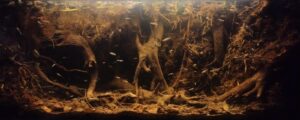Irrigation field
_st place in Biotope Aquarium Design Contest 2022

Volume of aquarium: 120 liters
Dimensions of aquarium: 100x30x40 cm
List of fishes: Anabas testudineus
Gambusia affinis
Pila ampullacea
Barbodes binotatus
List of plants: aquatica Ipomoea
Description of Decorations and Substrate: The wood and fine roots of Ipomoea aquatica the rocks are covered in mud debris that is eroded by rainwater and dry leaves at the bottom are covered with fine mud.
Description of Equipment: Recent Power liquid filter
Model AA-103
Voltage 220-240v
Frequency 50Hz
Watts 25w
H-max 1.5m
F-max 1300L/H
Neon 14 Watt size 1cmx50cm
Water Parameters: 23°- 25°c
Additional Info:
Aquarium video:
Description of the Area Surrounding the Biotope: Rice field irrigation comes from the Wirolegi River
And it is divided into dozens of waterways to irrigate the fields and channeled through the bushes when it rains the water there overflows beyond the irrigation that’s when all the fish are dragged from the Wirolegi River to the irrigation fields and begin to breed in the summer
Description of the Underwater Landscape of the Biotope: Irrigation water passes through more than tens of basins, each basin contains fibrous roots and wood that is carried away during floods
Description of the Habitat Parameters: The water in the irrigation of the rice fields is very clear with a temperature of 23°-25°c but the water there can be dirty when there is plowing of the fields
List of Fishes and Invertebrates Occurring in the Nature Biotope: Anabas testudineus, Gambusia affinis
Pila ampullacea, Channa striata, Barbodes binotatus, Rasbora argyrotaenia, Macrobrachium rosenbergii
List of Plants Found in the Nature Biotope: Setaria viridis, desmodium gangeticum, Hoya discidia euonymus fortunei
Threats to the Ecology of the Biotope: Aquarim was created to change people’s thinking, to be more careful in releasing foreign fish they have, in the river, and to maintain local wisdom in the area, Mystus is one example of a fish that is very difficult to find because it is displaced by the fish Oreochromis niloticus, which is a fish from the African Nile valley, the fish Oreochromis niloticus is a fish with very fast reproduction because this species of fish tends to be predatory and eats bottom-dwelling fish such as Barbodes binotatus which is endemic to Indonesian waters.
Sources of Information:
https://docs.google.com/document/d/1-SRw099ffOWHoySseKqqkBIFkYZaIOa_/edit?usp=drivesdk&ouid=107635691841122521397&rtpof=true&sd=true
